Stellar Kayaks and Surfskis
Stellar Kayaks and Surfskis was established in 2009 and launched its first surfski models in 2010 of which I was a part of. The USA distribution is located in Northfield, Massachusetts, has grown dramatically since then, becoming one of the premier brands of kayaks and surfskis in the marketplace. Dave Thomas and Ed Hofmeister designers of Stellar Kayaks and owners of the USA Distribution live in Northfield and can be found at the local tri races or surfski races when not in China where the boats are built. Dave and I raced the the S2E surfski at the Nationals only a few weeks ago. Dave, a former collegiate rower and coach was in the second seat of the double. His coaching skills showed as he told me where the fastest lines of the river were. Also, as my stroke rate would drop several times over the 12 mile race, Dave would say in his coaching voice “okay give me 10 hard strokes, here we go”. I loved it. We came in a fast second, not too far behind the first place finishers.
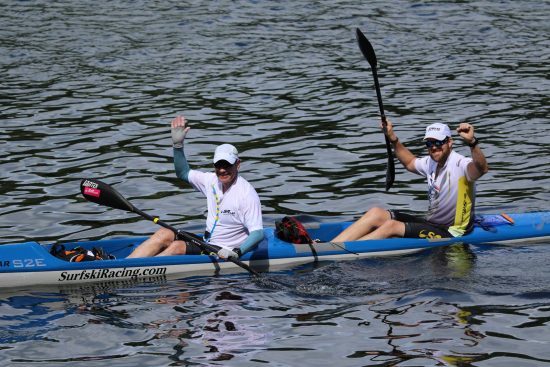
Dave Thomas and Wesley Echols, 2016 Nationals, Northfield, MA
Since 2010 the line up of surfskis has grown to meet the needs of all kayakers which include S14S, S16S(new), S18S, SR 2G, SEI 2G, SEL 2G, and SES 2G along with the S2E double. The kayak line includes 10 different models plus the addition of the K1 Apex Trainer and K1 Apex and the newly design racing kayak, the Rapid. Stellar has the widest selection of composite kayaks and surfskis in the world with five different layups. The line covers the recreational kayaker to the surfski racer at every different skill level.
Like cars, surfskis have cycle changes that improve the pre existing model. These changes could be minor or they could be major depending on many factors. Most car manufacturers have a five year time frame for major changes though many will make minor changes during the five year period called mid cycle updates. In 2015 – 2016 Stellar re-designed most of its surfski models and added or deleted others. The SR, SEI, SEL, and SES are all now on their second design so I call them 2nd generation(2G) to distinguish them from the first generation (1G) versions. These models are all distinct and try to span the the various skill levels of surfski paddlers in addition to the S18S that has been updated over the years but not totally redesigned. The SEI 2G is the latest redesign.
During this six year time frame, Stellar has had many firsts in the industry. I think it bears repeating Stellar’s first since paddlers have short memories: first to have pre-unidirectional carbon surfski; first to have 3 point foot plate along with cam locks; first and still only manufacturer to be ISO 9001 Certified Facility which is one of the reasons our quality leads the industry; first to produce a ski designed specifically for the smaller paddler(SES),and the first kayak line of truly light weight composite boats.
SurfskiRacing.com: #1 in Surfski Reviews
I have owned and reviewed more surfskis than anyone in the world. Most are charted below or on other charts on this site. In addition I have paddled many other skis though not reviewed them formally. So my expertise goes well beyond my five years with Stellar. Now, I typically paddle, race, and give instruction in the SES’s, SEL 2G and now the SEI 2G, and the Van Dusen Mohican(pure flat water), in varying conditions in New England. I try very hard to give the paddler a true sense of the speed and stability of all skis, not just the Stellars. Over the years, I have gotten hundreds of “thank you’s” for all the information on the site. I appreciate all the kind words. Chris Chappell and I started the site in 2009 as a platform to sell one of the first surfski DVD’s, “Surfski Basics” done with Mark Ceconi that was a success. Greg Lesher now does the SurfskiRacing Results and tabulations along with his humorous race summaries.
The link below is the comprehensive tables and charts of most of the skis I have reviewed over the years. SEI 2G not added yet to this chart.
Surfski Reviews and Chart
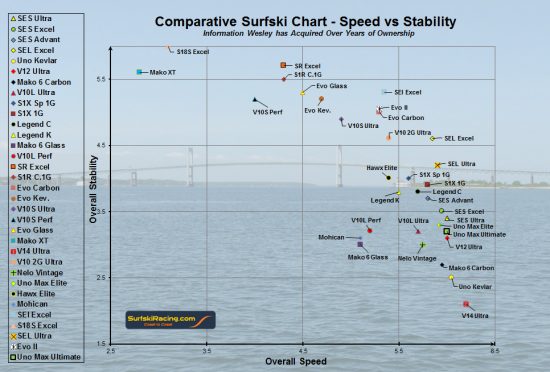
Whether one ski is the right ski for you, depends on many factors that I have outlined over the years in many reviews and articles. Many serious racers will ultimately need two skis: one flat water ski(faster, less stable) and one ocean ski(more stable). Many other paddlers will want one ski that can do it all, the VW GTI of surfskis. The newly designed SEI 2G will be the can apply to both situations.
When purchasing a new ski or upgrading, you need to answer the following questions honestly: What is my goal in buying a ski? What water will I be training on? How many times per week will I be paddling? What is my current skill level? Will I own more than one ski? What is my hip size and inseam? What is my age? How much am I willing to pay for a ski? Am I loyal to a particular brand or do I want the ski that meets my needs despite a particular brand?
SEI, Stellar Intermediate Surfski
Within the Stellar line up, the progression of performance skis goes from the S18S, SR, SEI, SEL, SES in that order of stability and speed. All these are very distinct skis in their own right. Within the Stellar lineup SEI 1G and 2G are 18.1 inches in the beam and 2o feet long. That 18 inches in the beam is bordering on high performance intermediate to advanced. Notice that the SEI 1G on my chart is ahead of the intermediate skis, but just below the advance skis. The SEI 2G will move up on the speed/stability ratio, a feat hard to do.
The SEI 1G was our first attempt at a more ergonomic bucket in our line of skis before we totally revamped the SR, SES, and SEL in 2015-1016 and discontinued the SE. The difference between Stellar’s first generation ski (1G) and second generation (2G) is dramatic. The SEI redesign is follows the same direction.
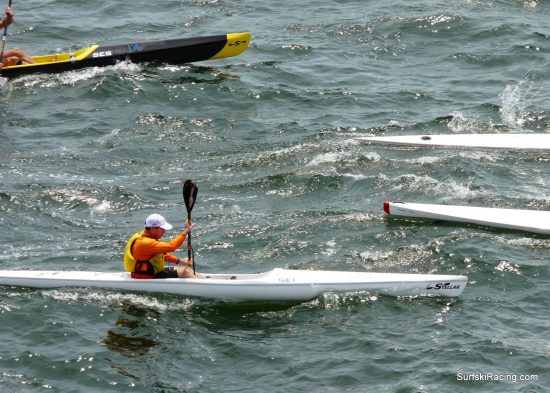
SEI 1G at 2013 Ride the Bull
SEI 1G vs SEI 2G
Labeled an intermediate ski, many intermediate paddlers were turned off by the SEI 1G’s primary stability, having gotten used to the more stable intermediate skis in the market. So many paddlers would try the SEI 1G and could not get past the primary stability and the roll rate in bigger conditions. The other noted concern for some mid to smaller paddlers was the large bucket size of the SEI 1G. Although I must say, as an expert in padding out a ski, I padded out my SEI to perfection and to this day, I can paddle the SEI 1G all day with comfort. However, the time had come to improve the 1G. I gave my substantial input to Dave Thomas and Ed Hofmeister on the redesigned SEI 2G. I told Dave specifically, if he and Ed get this right, the SEI 2G like the SR 2G would be an overwhelming success.
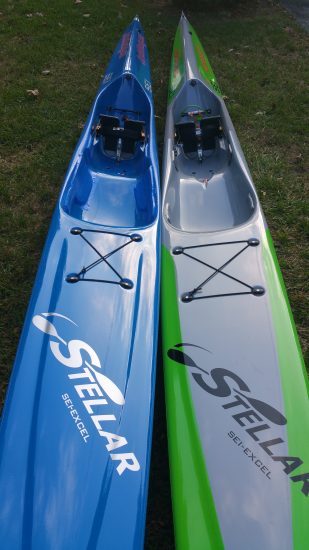
Beautiful Colors, Blue is SEI 1G, Green SEI 2G
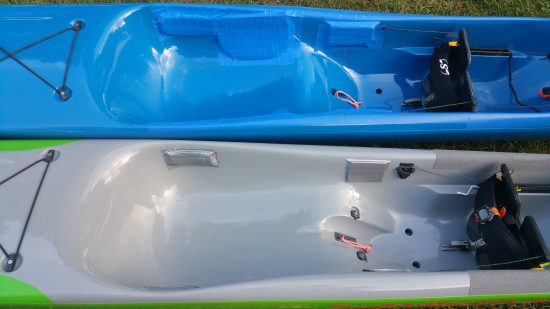
2G bucket is narrower, rounded, tapered with low gunwales for confident remounting. Much less padding needed. Winter clothing No Padding needed.
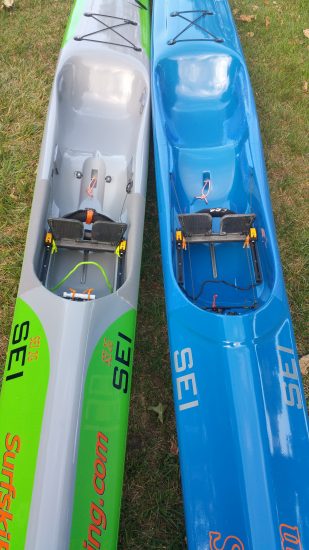
Catch is 1 inch more narrow on 2G. Volume decreased in footwell dramatically.
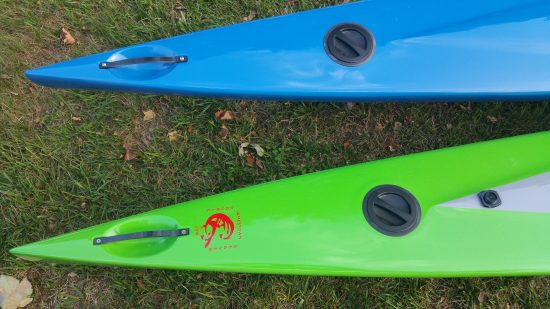
Rudder moved forward for better control.
SEI 2G Excel Layup with 5 inch rudder and 8 inch rudder.
My first paddle in the SEI 2G was June 23, 2016. I time trialed it right out of the wrapper, on my 1.63 mile time trial course. I was giddy with its performance. To average 7.3mph or do an 8:10 pace was very impressive. Typically intermediate skis are in the 8:30 miles per minute range.
1st Time Trial SEI 2G
SEI 2G 1st Time Trial.
Here is what I wrote in my notes on Garmin Connect on the first paddle: “Superb Glide on flat water and even better catching bumps. Tiny ocean bumps, no wind and it accelerates so easily on to wave and then once on the wave it accelerates even more and maintains the glide on the wave. This is one of my fastest times in intermediate ski. I have had faster times but in windy conditions. This is so impressive because today was flat but with tiny bumps. Seating excellent, low gunwales and lowest at reentry point at hips. Nice turning. Like a souped up SR on steroids. Love it. Fastest intermediate ski by far. Feels sized right with low gunwales just right volume. Can’t wait to paddle in conditions.”
I have put many miles on the 2G since that first time trial. It will not approach the advanced or HPS class of skis like the SES’s, V14, Uno Max, Mako Elite, Nelo 560, etc, yet it is the fastest intermediate ski and takes it place just below the HPS in terms of speed but more stable. While the SEI 1G previously held this title, the SEI 2G exceeds the SEI 1G. Why? Design, Design, Design. First of all, the seat is moved forward to catch bumps and to be able to continue to accelerate down a wave. Think about it. How many of us, lean forward at the hips, trying to catch a wave and once on it, continue the lean so the ski maintains its speed. Contrary, leaning back slows down the ski. By placing the bucket slightly more forward, the ski does the work for you. You would not want to move the bucket too far forward because it would be nose heavy or become too unstable in mixed conditions as some manufacturers have found out over the years. Secondly, we moved the rudder slightly forward for better handling. Now the SEI 2G can round a buoy or cross a wave with aplomb. We also took out the extra space in the footwell, and redesigned the bucket shape that is now similar to the SR 2G and SEL 2G, rounded and more tapered. The gunwales are much lower for easy remounting. This is key for rough water paddling knowing you can get back in your ski! The catch is more narrow than the 1G as well. These are the obvious changes.
Its all about the Glide!
The not so obvious change is the hull design. Dave and Ed changed the hull design to maximize the stability/speed ratio over the 1G. The result is superior GLIDE! Glide, that’s right! Some skis have it and some don’t. In our line, even the popular novice ski S16S(16ft) has glide. How can a 16 foot ski have glide? Modern Design. The SR 2g has it too and the SEI 2G has even better glide. Glide is that sweet sensation of a ski that maximizes its speed between strokes and accelerates early on with less power required. Some skis, you must keep the power up to maintain the speed. They could be fast skis, but once you let off the power for a few seconds, the boat slows and you have to power it up again. If you have not experienced Glide, than you have not paddled enough skis. Better glide means a more efficient running ski. This ski has some rocker but has less than the 1G, making it faster in the flats. So a newly designed ski with excellent glide, moderate rocker and 18 inches in the beam, equals? You guessed it: SPEED in an efficient stable hull design.
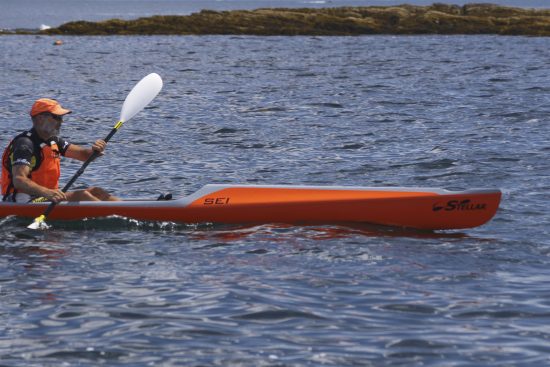
Joe Zellner, top endurance paddler in SEI 2G.
Racing the SEI 2G
I contemplated which ski to race in this year’s Blackburn, SEL 2G or SEI 2G. I chose the SEI 2G since this would be the first race paddling the SEI 2G. I must hold the record for racing a different ski for most of my 14 years racing in the Blackburn. While hoping for a a bigger Blackburn day, the 19.5 mile Blackburn is a perfect venue for testing skis, with mixed conditions and a variety of racers in various boats. Pick the wrong ski on a big day, or a ski over your skill level and you will pay with massive boat fatigue, or you will be turning around at the mouth of the Annisquam as many did in 2015(not me, SR 2G).
While it was not my best Blackburn, I felt comfortable and confident in the SEI. I did use a modified 5 inch rudder since it was a flat day. My best 2 miles was my last 2 miles. Peter Kahn, who you see at the start of the Blackburn (2.24 in video), dropped me at mile 2 but I caught Peter as we approached the Dog Bar at mile 17. As we rounded the Dog Bar, the dog fight began! Peter and I literally were side by side as we upped the tempo for a 2 mile interval to the finish. I did manage a short lived 2 boat length lead when the ferry came by with a large wake. I kept paddling while Peter slowed. In the end, Peter beat me by 7 seconds coming in 12th and 13th respectively. Peter did not have his best race either but it was another exciting finish for us. This was the third time Peter and I have finished within seconds of each other in this race. I was very pleased with the SEI, fast and stable, ready for any conditions and comfortable. All the components you need in a race, particularly one like the grueling Blackburn.
Wesley’s 14th Blackburn Challenge from Wesley Echols on Vimeo.
Paddle The Bay 2016 Video from Wesley Echols on Vimeo.
Above is the Battle the Bay Race on my home turf of Newport/Jamestown. While I DNF at mile 3 due to jet lag, the SEI 2G rocks in washing machine conditions that are the standard of care in our waters that entail the Ride the Bull Race, Double Beaver and Battle of the Bay.
Above is Chris paddling the SEI 2G on a flat day on the Sakonnet. He paddled it for 2 hours and enjoyed. It fit him too.
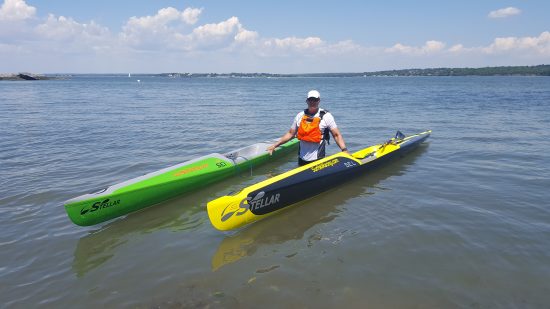
Chris holding on to the SEI 2G Excel and SEL 2G Ultra
SEI 2G Stability
The primary/initial stability of the SEI 2G is less than the SR but more than the SEL 2G for intermediate paddlers. These days I don’t put too much weight in primary stability unless you are a novice paddler. Often over the years Chris and I have discussed this very issue. I am sure this is a sign of all our bucket time in many, many skis and K1’s. Some skis have nice initial stability but often lack the confidence building secondary. So with bucket time, the primary stability of intermediate skis fades quickly in the recesses of your paddling brain and what you truly care about is secondary and how long it takes for you to trust the ski. That last sentence is meaningful. I am not going to belabor all the finer points of stability: skill level, conditions, rudder selection, paddler weight, boat weight, paddle selection, and the list goes on and on.
So the secondary stability of SEI 2G is superb. If you ever paddled the SR 2G and are an intermediate ocean paddler, you relish all the SR has to offer, wonderfully predictable secondary. The SEI 2G stability is wonderful and predictable as well, in any conditions but is a step up from the SR as it is designed to be. If you have paddled the SEI 1G, know that the roll rate is much, much less in the SEI 2G, so trusting the SEI 2G will be easier. The SEI 2G like the SR 2G, comes into their own in the choppy, mixed and bigger conditions. The advanced paddler albeit older (56) like myself, that prefers to drop down a boat level in stability in bigger conditions, will be in ski heaven. How would you know you are in ski heaven? You must try paddling it. If you think the boats that were designed a few years ago are as good as some of the newer skis, you would be mistaken, especially in regards to the SR, and SEI. Stellars have been known for their combination of speed/stability. I know quite few of my “advanced skill”racing buddies that are paddling intermediate skis. They could easily see improved race results in an SEI 2G Excel.
The SEI 2G tracks nicely down a wave with limited input from the rudder until you need it. When you do need it, you can put it any where on a wave and feel stable. The handling of all the 2G Stellar skis has improved greatly over the 1G’s since the rudders have been moved forward. I would loose one or two boat lengths on every buoy turn in the my 1G’s. No more, now I can typically gain a boat length.
Fit
Other major design changes include a better shaped, rounded bucket. The 2G bucket fits small hipped paddlers like myself with very limited padding, to the wide hipped paddler like Chris. It is a universal shaped bucket with the proper tapering to promote ergonomic leg drive and appropriate catch. It’s bucket theme is similar to the SR 2G but much more narrow. Bucket width is closer to the SEL 2G than the SR 2G. So most paddlers will find it comfortable. Like all the Stellar 2G’s we, took out the volume in front of the footwell. We also lowered the gunwale in the hip area so remounting is super easy which is what you want. The SEI 1G had a deep seat by Stellar standards and was more difficult to remount than it needed to be.
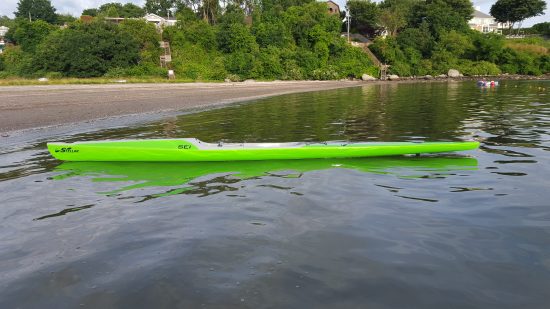
Nice lines
If you look at the SEI 2G you will notice it looks trim, not too much volume, not bloated. The newer designed skis have a reduction in volume compared to some of the older designs. The SEI 2G is right sized for the Mid sized paddler but can accommodate the large paddlers too. We continued the small hump design that has alway accompanied Stellar skis for better leg drive. The integrated leash attachment and 3 point foot plate using cam locks is standard along with the carbon handles and a 4 inch or 8 inch rudder and dual venturis.
Summary
Before the SEI 2G there was noticeable differences within the intermediate skis but now the SEI stands out among this class. The SEI 2G has a great combination of speed, glide, stability and volume. It takes the TOP SPOT on my list of “If you can only have one ski that can do it all with a change of rudder”? The SEI 2G Excel is THAT ski. I could paddle, train, race in all the ocean races (flat to Big) and be confident I would was in the right ski. It is like the 2015/2016 VW GTI that has got so many rave reviews including Car and Driver Top 10 Cars. It does it all. So when you have the opportunity, take the newly design SEI 2G out for a spin. I am confident you will be pleasantly surprised.
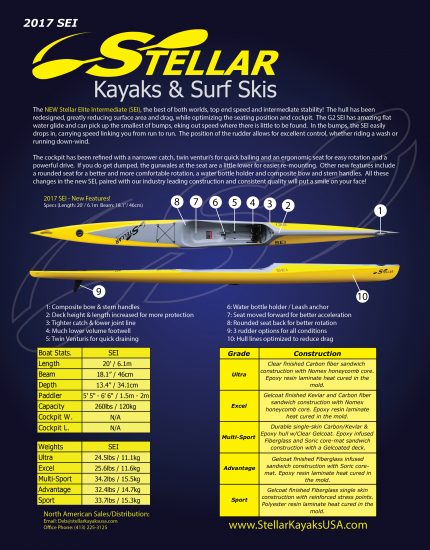
Specifications of the 2017 SEI 2G
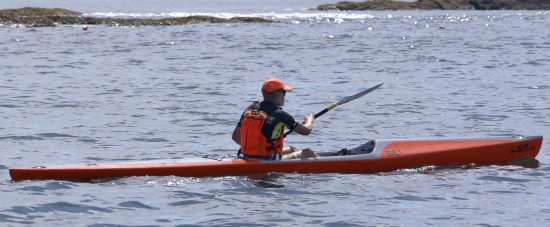
Top Endurance Paddler Joe Zellner his SEI 2G

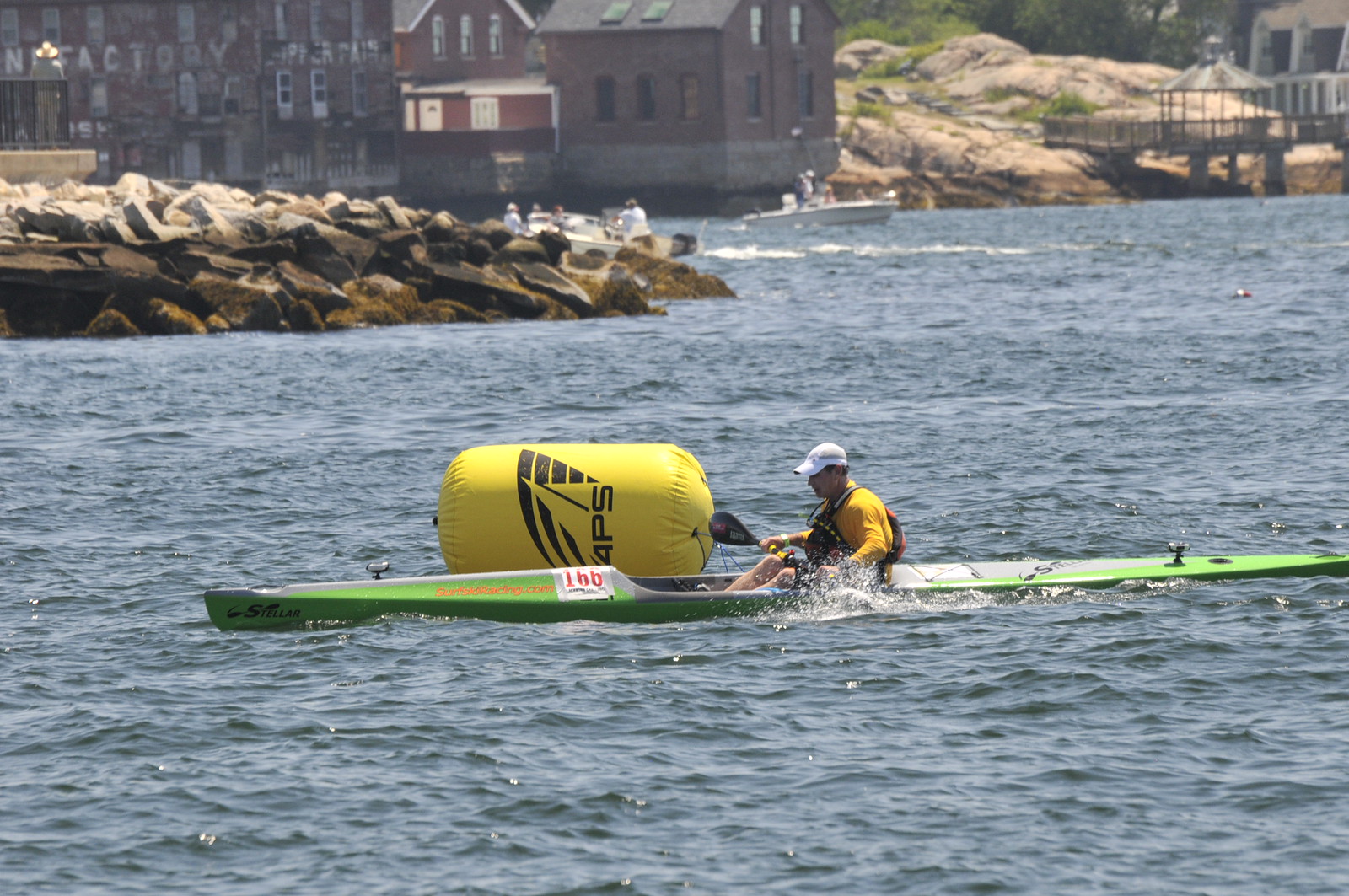
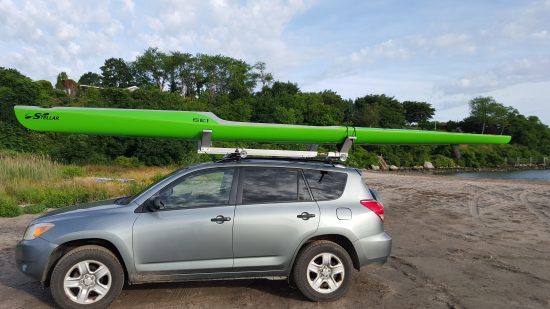
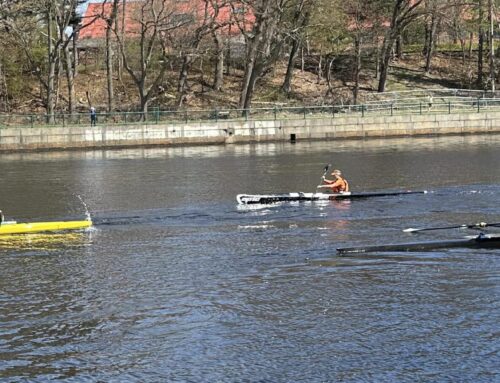
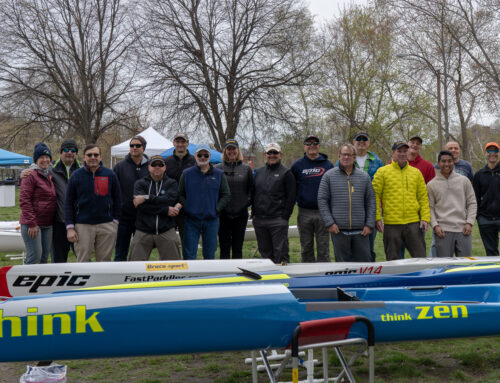
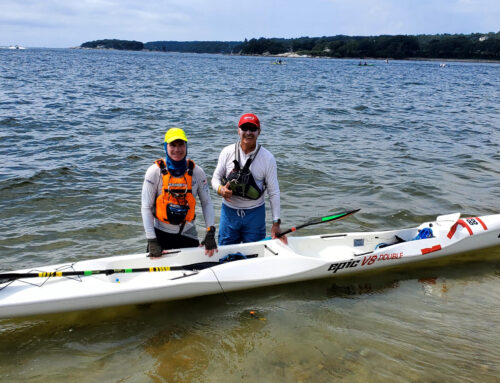
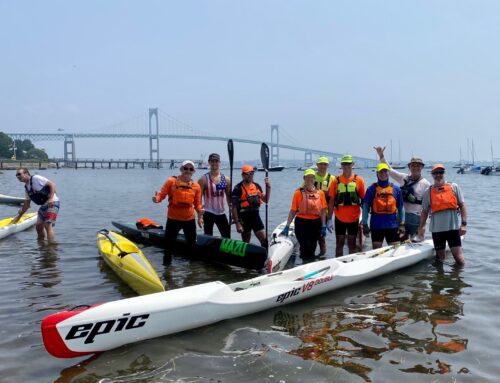
Leave A Comment
You must be logged in to post a comment.